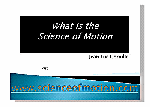| Testing Your Eye:
Where is the lameness? |

Click on Picture for video |
The horse is three years old turning four. He has been backed four, maybe five times at the date of this video recording. Therefore, it is not a training issue. At three years old, the horse is so lame that he is not capable of trotting with a rider on his back.
Can you figure out which limb is hurt. In the next newsletter we will show you where the lameness started, why it shows the way it does and how it was possible to restore soundness.
The lameness was not identified until the backing process commenced. It became apparent with the horse's adaptation to the rider's weight. "It should be borne in mind that the weight of the rider will increase two- or three-fold during locomotion and also that more energy is required by a mounted horse. This energy must be obtained by increasing the stance phase as to recover more energy during the swing." (Jose Morales)
After a large amount of money spent in photographing, scanning, and injecting every joint of the suspect limb, it was decided that it was a behavior issue since nothing wrong appeared on the medical examination.
As it is the case in 90% of the case studies, it was not a behavior issue but rather the expression of pain. Once we addressed the source of the problem, the horse became sound and perfectly willing to move forward. The reeducation lasted three months.
At the end of the session under saddle, the horse is somewhat better during a few steps. It was the result of a riding adjustment. This detail may help you to figure out where the lameness originates.
Tell us which leg is the source of the problem. E-mail your thoughts at helyn@scienceofmotion.com
This case is extreme but it illustrates a process which, to a lesser degree, limits many horses' ability to perform at their fullest potential.
Almost all horses enter life with a morphological flaw, back muscle imbalance, limb kinematics' abnormality, or other imperfection that the horse's brain learns to protect or compensate for, but does not have the intellectual capacity to analyze and therefore to correct. If a horse is exploited in the show ring without addressing the imperfection, sooner more than later, lameness will be the likely outcome. The gait abnormality created by a specific lesion is the gait abnormality that will cause the lesion." (James R. Rooney)
|
|
| What is the Science of Motion Part1 DVD |
 |
The accuracy of one's perception depends on the accuracy of the mental image associated with the feeling. Antiquated theories are wasting equines and humans talent.
This book is a new encyclopedia. It explains how the horse's vertebral column actually works. Each pertinent finding is explored from the rider and trainer perspective; how such new knowledge does modernize previous perceptions in terms of riding and training techniques.
Leading horses to performances previously inaccessible and recoveries beyond the scope of conventional views demands to think and act beyond the scope of conventional views. It should not come as a surprise that to the contrary of conventional thinking, the science of motion treats the horses back as the root cause of most limbs' issues.
Outstanding illustrations
The aim being to associate the proper mental image with the feeling, great attention has been given to the illustrations. The pictures show real horses playing and working. They clearly illustrate how limbs and vertebral structures have to be organized in order to maximize the horse's talent while preserving the horse's soundness.
Pertinent Practical Application
The practical application is based on two levels of experience: experience in riding and training horses at the higher level of competitions and experience in achieving "impossible" recoveries.
At every level, if the horse is talented enough, a gifted rider will gain some successes even if ignoring the horse's back muscle imbalance or other dysfunction. When the horse's dysfunction claims its toll and the horse becomes lame, the rider's skill needs then the support of actual knowledge.
Creating a functional horse differs widely from exploiting a dysfunctional horse. The fact is that if the techniques creating a functional horse had been applied on the first place, the horse would be currently winning instead of being reeducated.
A gifted horse will lead a good rider to victory. A great rider will give to the horse the gift of soundness.
|
|
| Training Program |
 |
"It is possible to defeat failure by analyzing its causes and correcting them, not by studying the conditions of success"
(Henry Greber)
Techniques exploiting dysfunctional horses don't concede failure; owners inject the hocks, change the bit, the saddle, and if failure persists, they criticize the horse.
Analyzing the causes compromising the horse's talent; we create functional horses, which is, sound horses performing at their fullest potential
Expressions commonly used in the equestrian language (general consensus) have a different meaning when they are analyzed in respect to actual knowledge of the equine physiology (science of motion.)
|
|